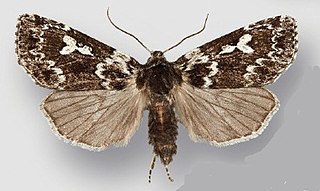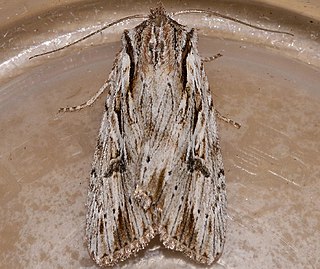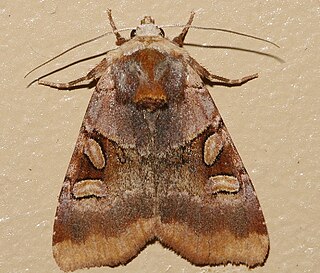
The Noctuidae, commonly known as owlet moths, cutworms or armyworms, are a family of moths. They are considered the most controversial family in the superfamily Noctuoidea because many of the clades are constantly changing, along with the other families of the Noctuoidea. It was considered the largest family in Lepidoptera for a long time, but after regrouping Lymantriinae, Catocalinae and Calpinae within the family Erebidae, the latter holds this title now. Currently, Noctuidae is the second largest family in Noctuoidea, with about 1,089 genera and 11,772 species. This classification is still contingent, as more changes continue to appear between Noctuidae and Erebidae.

Xestia is a genus of noctuid moths. They are the type genus of the tribe Xestiini in subfamily Noctuinae, though some authors merge this tribe with the Noctuini. Species in this genus are commonly known as "clays", "darts" or "rustics", but such names are commonplace among Noctuidae. Xestia moths have a wide distribution, though they most prominently occur in the Holarctic.
Xestia elimata, the southern variable dart or variable climbing caterpillar, is a moth of the family Noctuidae. The species was first described by Achille Guenée in 1852. It is found in the eastern part of North America, including Georgia, Tennessee, North Carolina, New Jersey, Maryland and New England.

Xestia badicollis, the northern variable dart, northern conifer dart or white pine cutworm when referring to the larval stage, is a moth of the family Noctuidae. The species was first described by Augustus Radcliffe Grote in 1873. It is found in North America from Nova Scotia to North Carolina, west to Missouri and Ontario.

Xestia dilucida, the dull reddish dart or reddish heath dart, is a moth of the family Noctuidae. The species was first described by Herbert Knowles Morrison in 1875. It is found in the United States from southern Maine to northern Florida, west to central Ohio and eastern Texas.
Xestia normaniana, or Norman's dart, is a moth of the family Noctuidae. The species was first described by Augustus Radcliffe Grote in 1874. It is found in North America from Nova Scotia across southern and central Canada to Alberta. In the eastern United States it ranges from Maine to eastern Minnesota, and south along the Appalachians to western North Carolina. It has recently been recorded from Tennessee.

Xestia perquiritata, the boomerang dart, is a moth of the family Noctuidae. The species was first described by Herbert Knowles Morrison in 1874. It is found across North America from Newfoundland, Labrador and northern New England, west to central Yukon, British Columbia and Washington. There are several disjunct populations, including one in the Great Smoky Mountains National Park and the Rocky Mountains in Colorado and a coastal bog in central Oregon.

Noctuina is a subtribe of cutworm or dart moths in the family Noctuidae. There are at least 170 described species in Noctuina.
Xestia verniloides is a species of cutworm or dart moth in the family Noctuidae. It was described by J. Donald Lafontaine in 1998 and is found in North America.

Xestia infimatis is a species of cutworm or dart moth in the family Noctuidae. It was described by Augustus Radcliffe Grote in 1880 and is found in North America.
Xestia laxa is a species of cutworm or dart moth in the family Noctuidae. It was described by J. Donald Lafontaine and Kauri Mikkola in 1998 and is found in North America.

Xestia oblata, known generally as the rosy dart or ruby dart, is a species of cutworm or dart moth in the family Noctuidae. It is found in North America.
Xestia cinerascens is a species of cutworm or dart moth in the family Noctuidae. It is found in North America.
Xestia vernilis is a species of cutworm or dart moth in the family Noctuidae. It is found in North America.
Xestia ursae is a species of cutworm or dart moth in the family Noctuidae.
Xestia colorado is a species of cutworm or dart moth in the family Noctuidae.
Xestia inuitica is a species of cutworm or dart moth in the family Noctuidae. It is found in North America.
Xestia liquidaria is a species of cutworm or dart moth in the family Noctuidae. It is found in Europe and Northern Asia and North America.
Xestia imperita is a species of cutworm or dart moth in the family Noctuidae.
Xestia okakensis is a species of cutworm or dart moth in the family Noctuidae.








